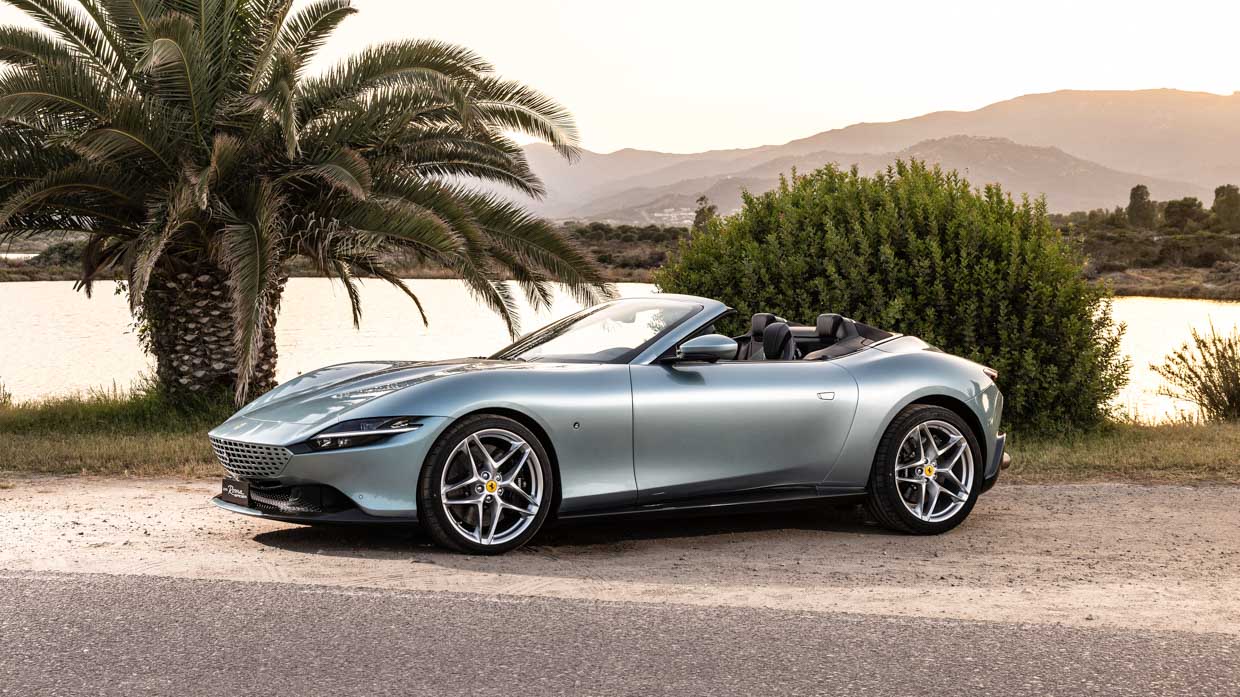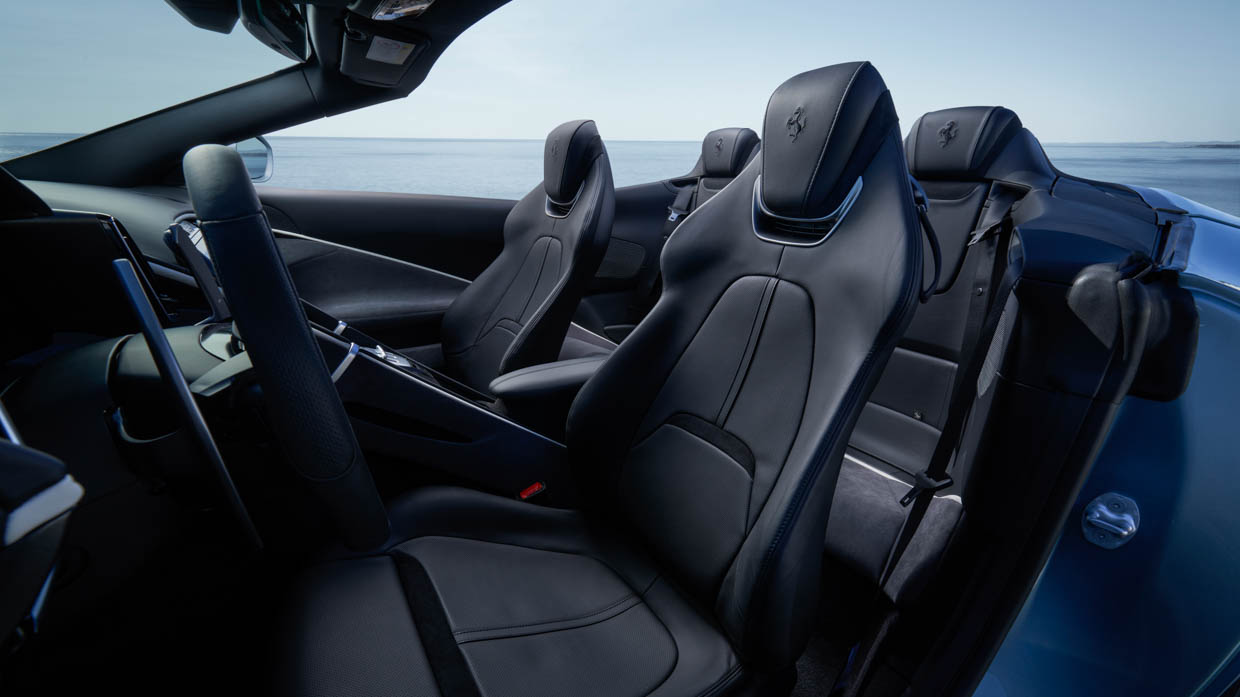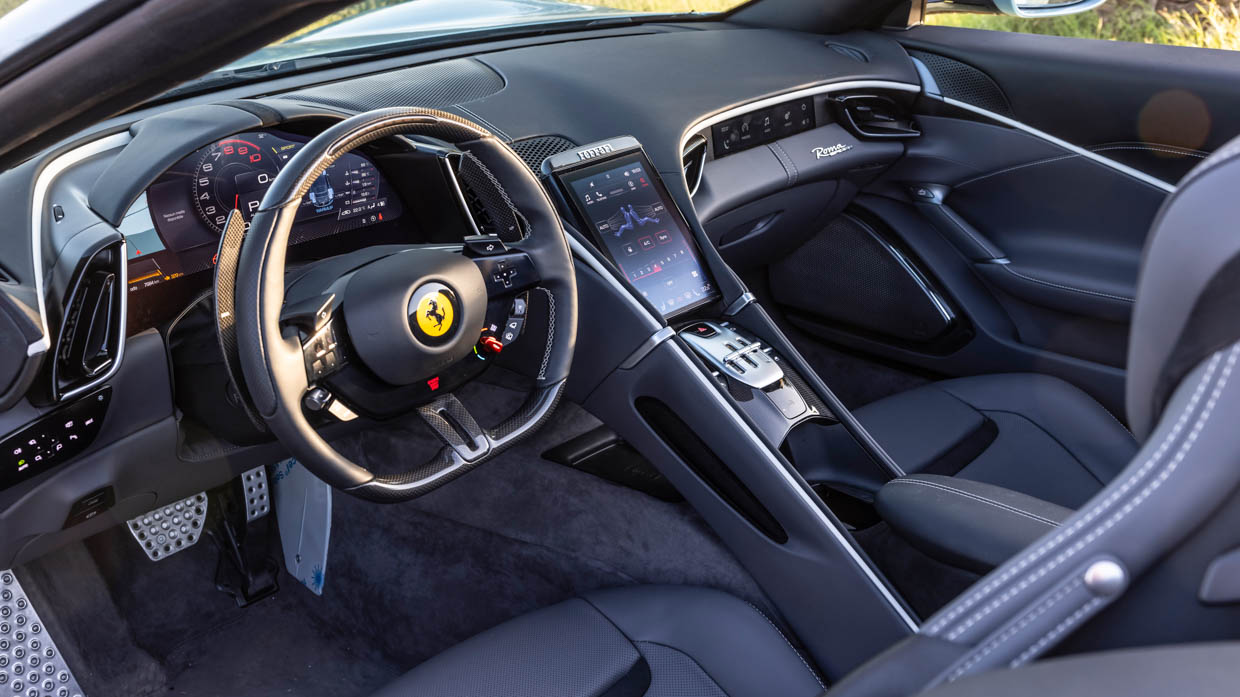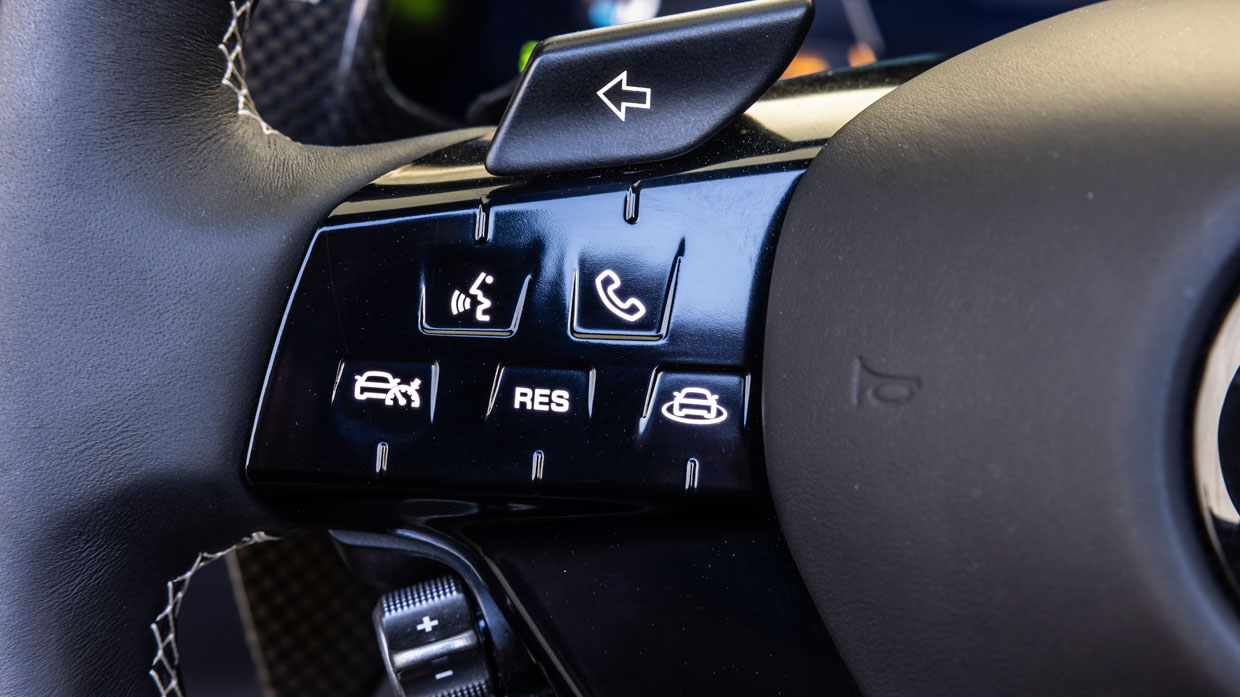-
Car Reviews
- Car News
-
Car Comparisons
Latest comparisons
- Chasing Deals
Ferrari is asking top money to step up from the Roma coupe to its new Roma Spider – but is the brand’s first soft top in 20 years worth the spend?

It might be hard to believe that a vehicle costing a little over $400,000 is the entry point for any car brand, but that is exactly the case for the coveted Ferrari range and its Roma coupe.
Introduced to replace the Portofino in 2020, the Roma is the cheapest new model available from the prancing horse stables.

But just because the Roma’s an entry model, that doesn’t necessarily mean it is short on features to talk about.
This is a 456kW V8 turbo Italian supercar with classic Ferrari styling, monstrous performance, opulent interior and a soundtrack to match. And now there’s a convertible version.
As you might expect, the soft top version attracts a premium over the coupe just as many convertibles from other brands do when compared with their tin-top equivalents.
For example, stepping up to the convertible version of BMW’s 430i from the coupe costs an extra $17,000, compared to the P450 R-Dynamic coupe, Jaguar’s F-Type convertible costs about $5000 more, while Ford’s Mustang costs approximately $6000 to have the soft-top version.

However, with the introduction of the new Ferrari Roma Spider, the price compared to the coupe version has increased by about $110,000. That’s not a typo.
How does Ferrari justify the price premium and, more importantly, is it worth the extra investment over the Roma coupe to jump behind the wheel of the Roma Spider?
As is typical with most ultra-high-end car brands, the options catalogue can be a very expensive playground.
Our test car had been optioned up with a few extras including the passenger dash display, neck warmers, Magneride suspension, adaptive LED headlights, ventilated seats with extra leather upholstery, and the full Ferrari ADAS pack.

There’s even special stone-chip protection film which is tailor made for the Roma and even has the prancing horse subtly included in the corner.
As well, carbon fibre trims had replaced the standard items on the front spoiler, rear diffuser, under-door and sills, dashboard inserts and upper centre console, along with a beautifully sporty steering wheel which is also in carbon but brings heating, carbon fibre shift paddles and even an LED shift light built into the top of the rim.
Special Celeste Trevi exterior paint and shimmery black and silver weave roof fabric complete the list of extra-spend items for this particular car and are somewhat representative of what the average customer might request.

One standard item is a plaque mounted under the boot lid which lists every option fitted to the car from new, allowing a future owner to see exactly how the car was delivered. Ferrari didn’t include an as-tested price but, as is often the case, if you have to ask, you probably can’t afford it.
Standard inclusions and options align almost identically with the Roma coupe but the big news here is the folding soft top.
Ferrari hasn’t introduced a fabric-roof convertible for about 20 years and, if you exclude mid-engined models, there hasn’t been a folding fabric front-engined soft top Ferrari for more than half a century.

The Roma Spider’s roof is constructed using five layers of material for excellent temperature and sound insulation, especially if you option the thermally insulated windscreen fitted to our car.
Folding the roof takes just 13.5 seconds and is possible at speeds of up to 60km/h, and all that the push of a single button.
Even when the roof is stowed, a tonneau cover is upholstered with the same fabric as the roof allowing the same shimmering texture to be appreciated even when rolling topless.
Also unique to the Spider is a clever wind deflector which pops out from the rear ‘seat’ back with a dashboard positioned button and fills the void between the front seats and tonneaux.

With careful aerodynamic design, the flap directs air down through a slot in the cover simultaneously slashing wind buffeting in the cabin while holding cooled air in the cabin with the occupants.
Not only does the feature dramatically boost cabin comfort when the roof is open, it also leaves the beautiful Roma Spider exterior aesthetic completely unmolested by ugly spoilers and fly-net style diffusers that some other manufacturers offer.
It’s often assumed that choosing a convertible sports car over the coupe equivalent sacrifices driving dynamics in the name of open-top enjoyment, but Ferrari designed the Roma Spider to compromise as little as possible in ride and handling.
The coupe’s chassis was not bolstered with extra structural reinforcement as an afterthought to create a convertible Roma, with its structure instead designed in parallel with the coupe from the outset.

The result is not entirely unique, but it is still dramatically different when viewed side-by-side.
That meant Ferrari could create the Roma Spider without adding excessive weight – just 84kg over the coupe – and torsional rigidity and stiffness is only marginally impacted despite the removal of the tensioned roof panel. It’s an engineering triumph in practice.
With low 30 degrees indicated on the thermometer and Sardinia’s southern mountain roads beckoning, conditions could not have been more perfect for drop-top Ferrari motoring.
On straight roads, the Roma’s primary ride is surprisingly composed with damaged roads and occasional speed bumps leaving the excellent ride quality totally unphased.

There’s a little suddenness to the secondary ride but nothing that’s not forgivable given what the Roma is capable of once the Manettino dial is flicked a couple of spots.
It’s breathtaking how quickly the Spider’s cruising elegance and relaxing demeanour changes into a savage supercar when the roads turn twisty.
Cornering speeds increase rapidly as confidence builds in the Spider’s capability and unbelievable grip. Weight distribution is close to 50:50 but the Roma manages so much more than a benign resistance to lateral acceleration.
Character and charisma abound with enough attitude and weight transfer to instil huge trust in the chassis.

Only once did the traction control light slap our wrist (right foot) thanks mostly to a deft calibration of Ferrari’s Advanced Driver Assistance System and the latest (sixth-gen) side slip control system.
Steering feel is almost absurdly sensitive enhanced by the slender and light carbon fibre steering wheel and the turn-in is not unlike an upscaled Mazda MX-5.
The Spider’s nose sniffs out a line through corners with lithe suppleness form the front suspension and a bit of roll onto the outside corner rather than the flat and lifeless nature too many sports cars exhibit in today’s market.
The tail end is wonderfully anchored however. With so much power pumped through just the rear wheels, it’s astonishing how capable the Spider is at transferring monstrous performance to the road.

There’s a sense it would be easy to get the Ferrari’s tail to wag out to every tight mountain bend but with zero room for error, Armco in the best scenario and free-fall in the worst case, we’ll save the tyre vaporising for a future track drive.
There’s no denying Ferrari’s engineers have worked miracles to preserve the coupe’s handling and dynamics without spoiling the lovely ride but the bit under the bonnet is arguably even more of a mechanical masterpiece.
A 3.9-litre flat-plane crank V8 with twin turbos produces 456kW and 760Nm but more impressive than this numbers is the way in which power and torque is delivered.
Ferrari’s adaptive boost prevents the full power figure being unleashed in the lower gears which allows easier tyre-slip prevention but, more memorably, imparts a sense of endless power and relentless acceleration.

Grab third gear with one of the delightfully crisp paddle shifters and the Spider lunges forward with the same manic force as it does in second or first. Actually, it feels even more aggressive in higher gears.
Bolted to the V8 is the same eight-speed dual-clutch automatic gearbox you’ll find in the SF90 – albeit with a reverse gear engineer in. It continues the same theme of sublime aggression with just about the most obliging and rapid responding transmission we’ve ever experienced.
The 90-degree V8 also has a linear delivery that enhances the sense of boundless athleticism and there’s a beautifully seamless handover from the monstrous torque wave into the realm of power somewhere in the middle of the rev range.

All the time, eight cylinders holler with a sound that is equal parts unmistakable flat-plane crank and also a classic demonic Ferrari anthem. Here’s where the Spider has one last typically Italian trick up its sleeve.
At the tail end, the Spider’s quad exhausts are unsilenced and controlled instead by electrically operated valves. This allows the volume of the engine report to be altered not according to speed or driving mode, but according to wind noise.
As the velocity increases, the utterly intoxicating and addictive engine noise is unfaltering and consistently heavenly regardless of the conditions – unless of course you happen to keep the loud pedal pinned through a mountain tunnel and, let me tell you, that experience never leaves you.
The Spider’s cabin does not disappoint and for such a driver-focused car, Ferrari has gone to lengths to make the passenger feel almost as special as the pilot.
Roma’s front row has been shaped into two distinct and separated cockpits with an enveloping capsule for each occupant.

The elegant almost organic pods allow the passenger and driver to feel both connected in the same vehicle but also individually considered.
In the case of the passenger, there’s a personal digital information screen beautifully integrated into the dashboard for their own use.
Complementing the digital display is a central portrait oriented screen for the general information and entertainment duties and while its 8.4-inch size isn’t class leading, the proportions allow the screen to melt Into the surroundings rather than stand out distractingly.
Breaking from tradition, much of the Roma’s switchgear is solid-state touch-sensitive including the engine start button which is a solid bar running the width of the steering wheel under the airbag/horn boss.

It’s a strange but likeable paradox of technology compared with the Spider’s aesthetic which harks back to the hedonistic 1950s and 1960s.
Easier to digest is the Spider’s gorgeous interior with exceptionally well ergonomically designed seating, fine leather and soft pile carpets, combined with contemporary carbon fibre trims including shift paddles and parts of the steering wheel rim, and soft LED lighting.
Technologically speaking the Spider is bang up to date with a full digital instrument cluster, wireless device charging, wireless Android Auto and Apple Carplay, although the latter two are still options.
Long gone are the romantic days of Ferrari manual gear selectors clacking through machined aluminium gates, but the Roma might have gone too far in its minimisation of transmission interface.

We would have liked to have felt more ceremony than nudging a microswitch to select drive or reverse, even if the backing plate does resemble the classic H-pattern gate.
What is almost erotically traditional though is the Manettino dial which looks as though it has been lifted directly from a Ferrari race car and appears to have been milled from a billet of anodised red velvet.
Its notchy clicks through the various drive modes are wonderfully divorced from too many manufacturer’s vanilla methods including boring push buttons or even the worst offender – modes buried in touchscreen sub menus.
Completing the exquisite interior design is the Roma ‘key’. A monolithic rectangular block of heavy metal that’s entirely composed of an enamel Ferrari badge on one side and nestles into its own receptacle in the centre console, becoming a part of the interior design itself.

But while both front occupants are very well looked after, the same cannot be said for people riding in the second row.
While there are a pair of ‘seats’ behind the front row they are practically a similar proposition to those found in the Porsche 911. That said, there are Isofix anchors for two child seats so there is at least some use for young families or perhaps grandparents.
When the roof is stowed, the folding fabric top occupies some space in the boot but not the rear seats so it can continue to be used for luggage whereas the boot shrinks further from a not-exactly-huge 255 litres.
The Roma introduces the most comprehensive selection of driver assistance and active safety systems yet seen in a Ferrari with lane-keep assistance and autonomous emergency braking with cyclist detection now joining the Ferrari safety systems suite.
Don’t expect to see a Roma crash tested by either Euro NCAP or ANCAP any time soon with forecast sales volumes probably not quite justifying the cost.

It’s a little-known fact that new Ferraris have the first seven years of scheduled maintenance included in the purchase price, so there’s no capped-price deals or extended packages to even consider. Everything is included.
Also, the standard three-year warranty can be extended up to four or seven years for an additional cost, while the Power 15 deal allows customers to increase the Ferrari warranty to up to 15 years, making it the longest warranty deal in the new-car market.
Ferraris are not exactly cheap but features like these are very appealing to customers as a massive boost to the convenience and ownership experience.
No matter which way you look at it, stepping up from the coupe version of Ferrari’s delicious Roma to the Spider comes at a significant cost and we’re not just talking a proportional increase relative to the initial coupe purchase cost – we’re talking about another quarter on top.
But what becomes clear after spending some quality time in the Spider’s cabin is that the extra outlay is not simply to have something taken away – as is the case in so many convertible conversions.

Spending the $520,300 brings a car that not only introduces the joy of warm summer nights, panoramic coastal vista drives, and uninterrupted access to that angelic/demonic engine note, it does so without significantly compromising anything of the Roma Coupe.
In tin-top form, the Roma is one of the easiest daily drivers to ever emerge from the prancing horse stables but now there’s a convertible version that does everything just as well.
The Ferrari Roma Spider is one of the few convertible sports cars that offers top-down motoring almost completely without sacrifice and that’s something worth paying for.
Key specs (as tested)
About Chasing cars
Chasing Cars reviews are 100% independent.
Because we are powered by Budget Direct Insurance, we don’t receive advertising or sales revenue from car manufacturers.
We’re truly independent – giving you Australia’s best car reviews.
The estimate provided does not take into account your personal circumstances but is intended to give a general indication of the cost of insurance, in order to obtain a complete quote, please visit www.budgetdirect.com.au. Estimate includes 15%^ online discount.
^Conditions Apply
Budget Direct Insurance arranged by Auto & General Services Pty Ltd ACN 003 617 909(AGS) AFSL 241 411, for and on behalf of the insurer, Auto & General Insurance Company Limited(ABN 42 111 586 353, AFSL 285 571).Because we don’t know your financial needs, we can’t advise you if this insurance will suit you. You should consider your needs and the Product Disclosure Statement before making a decision to buy insurance. Terms and conditions apply.
Indicative quote based on assumptions including postcode , 40 year old male with no offences, licence suspensions or claims in the last 5 years, a NCD Rating 1 and no younger drivers listed. White car, driven up to 10,000kms a year, unfinanced, with no modifications, factory options and/or non-standard accessories, private use only and garaged at night.
^Online Discounts Terms & Conditions
1. Discounts apply to the premium paid for a new Budget Direct Gold Comprehensive Car Insurance, Third Party Property Only or Third Party Property, Fire & Theft Insurance policy initiated online on or after 29 March 2017. Discounts do not apply to optional Roadside Assistance.
2. Discounts do not apply to any renewal offer of insurance.
3. Discounts only apply to the insurance portion of the premium. Discounts are applied before government charges, taxes, levies and fees, including instalment processing fees (as applicable). The full extent of discounts may therefore be impacted.
4. We reserve the right to change the offer without notice.